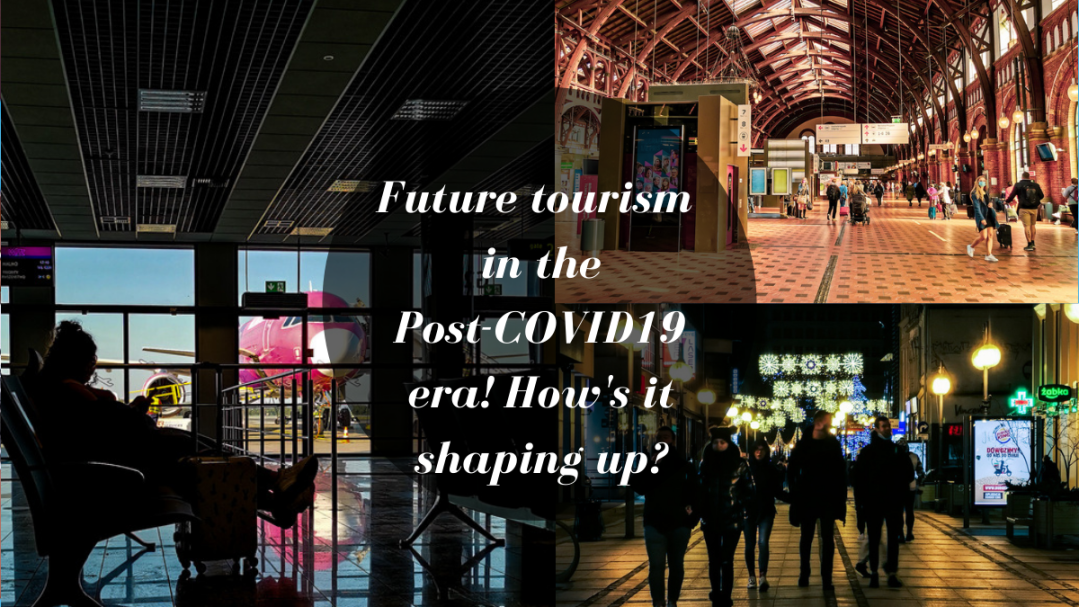Deserted city streets, vacant bars, and hushed city centres contemplate a future without many tourists around after COVID19 while many long for footfalls and crowds. While all the assumptions still lie veiled in uncertainty, there’s plenty of new travel trends and culture that has started to pop up.
It was more or less the same period last year when the world came to a standstill. One after another, every country went on securing their borders, and soon the entire world population was confined to the four walls of their house. The summer Olympics, major gaming extravaganzas, and some of the most popular global concerts and music festivals got cancelled/postponed. People held up and managed to retain their sanity even during the toughest times, patiently preparing for their future travels. But things did change; it started with habits, psyche, and even affected travel ways when there was some relaxation in rules. In the tourism world, the attitude of travellers and tour operators changed too.
While in some places the tourism world is struggling to survive, changes are quite evident in a lot of places. Leave alone the fact that it is obligatory to keep a mask and disinfectant handy, even the trust and comfort level while interacting with fellow travellers or the ticket seller is not the same. From keeping a close tab on the active cases in the destination to figuring out the testing procedure to staying in a designated quarantine, every traveller has a plenty of homework to do before going on a journey.
From physical hardships to mental stress, from prices to available options, from access to limited touristic infrastructure to being subjected to different rules and regulations by the government of the destination country, the list is long.
Every major historical event has brought the good and the bad as an outcome. Similarly, COVID19 also has its repercussions. While humans were confined to their homes, the ecosystem Steadily recovered from the non-stop battering it received from humans over the years. Canals and rivers turned out to be clearer than ever, faraway mountain peaks were spotted from cities, and wildlife ventured in the streets fearlessly. Skies turned bluer than ever, and there was a sudden check on overtourism. A lot of these surprising end-result made us believe that all the unsustainable means of travelling and the exploitation of natural resources must stop at once.
The tourism industry is reopening slowly, and people have eventually started exploring their favourite destinations. A few things will rebound to normalcy while there will be changes that will eventually find the confidence of people.

That said, I analyse some of the major changes that I believe the tourism fraternity will experience in the coming times.
1. Conscious traveling will get mainstream
After 2020, there is a possibility of a substantial rise in the number of conscious travellers. After seeing that evident changes during the lockdown, people are certainly going to take more ownership of their actions while travelling. The conscious travellers who are aware of their carbon footprints, impacts of litter, or even care about intangible tourist attractions will be seen as the new and young pioneers of conscious tourism in the post-COVID19 era. The discerning ones are going to be more focussed on surroundings, and less reckless with unnecessary expenses.
2. Finally some changing travel habits?
A search trend on google has revealed the fact that the travel pattern is likely to change in the post-pandemic era. To skip all the haste and uncertainty that comes along with the crowd, people are likely to choose small towns over major cities that are mostly crowded. This was revealed in this study by Tea Ceremony Kyoto Maikoya. The study, however, emphasised the fact that these travellers may not be first-timers.
Since the Google search pattern revealed a sharp decrease in the travel-related search queries online when compared between 2019 and 2020, it still backs the fact that the decline is overall. But some monthly search queries point out that people are looking for less-popular towns and not major tourist destinations, and these people are certainly not first-time travellers.
3. Changing experience for better?
According to a report from the UNWTO, international tourist arrivals worldwide plunged by 72 per cent on an average between January and October 2020. The consequences of this ongoing pandemic have turned out to be catastrophic for the tourism industry. Looking forward to future travels is perfectly okay but travel habits are certainly going to make a difference.
For example, the change in preference of destination, food, places to visit, and modes of transport preferred have a major say in deciding the travel habits of people. This difference is quite evident and can be termed as the aftereffects of the COVID19 pandemic. A study also revealed the fact that future travels would be longer and less frequent. The same article also concluded that indoor spaces would be avoided, and home rentals will be favoured over hotels.
4. Traveling getting more expensive?
The price pattern certainly affects domestic travellers and especially the people who do not belong to the rich & elite class. Since the travel restrictions are still pretty much in place, a real-time survey is tricky. But google search pattern reveals a lot. For example, the search query for “luxury hotels” was still better than that of “budget hotels” in places across Japan.
Flight tickets are another tricky area where the cost is likely to go down to lure more people into travel but eventually, they will get pricier than pre-COVID times. People will ultimately settle for easy and cheaper means of transport even if that means choosing a less green travel option if that requires them to pay more. The pricey accommodation and flight tickets will also mean that people will not waste their vacation time around casually, and will try to make their time count.
5. Virtual Travel is the future?
The lockdown during the pandemic also saw new travel trends emerging, and the local businessmen saw this as an opportunity to give people around the world a virtual tour of their exotic surroundings. Considering the example of Lapland – the northernmost territory of Finland which is profoundly dependent on regional tourism round the year. Soon after the lockdown came into the act, plenty of local tour operators and travel content creators came out with their cameras revealing the world to their beautiful surroundings. Lapland is popular for Northern Lights, Santa Claus hometown – Rovaniemi, husky and reindeer sledge, skiing, and tons of winter activities that give this place the dreamy aura.
Similarly, other tour guides from across the world came out on Instagram and Facebook live to show their exotic part of the world, which also fetched good responses from people far away sitting in the confines of their houses.
According to this article by Tea Ceremony Kyoto Maikoya, some respondents agreed to be interested in online experiences and virtual tours for approximately half the price they’d pay normally. While many respondents said they would not be interested in virtual experiences because it won’t be a real encounter.
It can be inferred that virtual tours and online events can be saved for special occasions. And it will be difficult to replace original tours and experiences.
6. Slow travel the next big thing
Slow travel could be a thing in times to come. The fact that there will be too many restrictions still in places, and a big uncertainty over the prices and regulations of accommodations and various tourist attractions will make people more thoughtful. Despite taking up multiple week-long trips maybe it’s the time people will start planning fewer, longer, and slower itinerary. Focussing more on the benefits of slow travelling, it can be maintained that there will be a multifaceted impact of slow travelling not just on the planet but also on the local communities that live on it.
The industry that accounts for 10% of the global GDP has the backing of many small businesses. So a slow way of travelling will only make people explore the roots on a deeper level while making true and authentic connections. This will lead to positive benefits economically and socially. This can also prove to be massive support in the sustainable tourism world. People becoming more humble and responsible will only refine the tourism world – slow & self-powered travel will make tourists more humble.
7. Emission check attained?
While many researchers still argue that the drop in emission rate because of COVID19 isn’t enough to tackle climate change, the fact also remains that the lockdown DID bring emissions to an all-time low. Some abrupt and unprecedented changes in the environment took the world by surprise. It started from the see-through waters of canals in Italy and went up to the extent of people seeing the Himalayan Peaks from many North Indian territories. While air and road transport emission have been the major contributors to carbon emission across the globe, these two segments came to a standstill during the peak of the pandemic leading to many such noteworthy changes evident in the surroundings. And Los Angeles experienced the best air quality in 40 years, thanks to the reduced carbon emission during the pandemic.
With all-reduced day-to-day commuting and offices going remote, emission check can certainly be a reality in the post-pandemic era but a lot will also depend on the bigger corporations that account for a large chunk of emissions around the world. But the best part is, while the world has been under lockdown for over a year, it has allowed us our space and given us time to rethink our strategies. it will be interesting to see how well we adapt to the changing environment and what’s the future plan-of-action to tackle the challenges around us.
8. No more Overtourism?
Of all the uncertainties looming over the tourism industry, overtourism is a major talking point that will determine its future course. Before the pandemic hit, plenty of exotic locations around the world were already dealing with excessive tourism. Some places and tourist attractions even had to close down after being overwhelmed with tourist arrivals. While for some places, the COVID 19 pandemic acted as a fresh lease of hope.
Based on the study reports shared above, it was also revealed that lots of people are just patiently waiting for the lockdown rules to be withdrawn. With all their money stashed over the year, and plans for future travels sorted, these tourists are gonna rush to their favourite vacation spot once there’s no lockdown/restriction around.
In the post COVID19 era, the tourism and hospitality fraternity is expecting to experience its fair share of pros and cons that the industry will be left with.
I, for one, am confident that exciting times and some interesting alternatives await the travel world. But tourism will live to educate, inspire, and enchant us! The trends that will ultimately be the byproduct of this pandemic will take the industry further. What are your views on this? Please share in the comments below. If we partake in similar views, please share them across. Thanks for reading


I can’t wait to travel again. I’m in the process of making sure my service dog has all his IDs ready for our next trip: https://www.dogsonplanes.com/shop/pet-ids/. It’ll be interesting to see how navigating an airport with a dog works these days with all of the new guidelines.
LikeLike
Great! That sounds amazing and interesting 😀
LikeLike